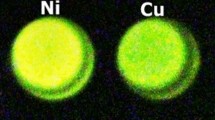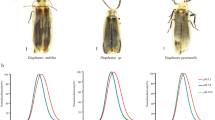Abstract
Firefly luciferases usually produce bioluminescence in the yellow-green region, with colors in the green and yellow-orange extremes of the spectrum being less common. Several firefly luciferases have already been cloned and sequenced, and site-directed mutagenesis studies have already identified important regions and residues for bioluminescence colors. However the structural determinants and mechanisms of bioluminescence colors turned out to be elusive, mainly when comparing luciferases with a high degree of divergence. Thus comparison of more similar luciferases producing colors in the two extremes of the spectrum could be revealing. The South-American fauna of fireflies remains largely unstudied, with some unique taxa that are not found anywhere else in the world and that produce a wide range of bioluminescence colors. Among them, fireflies of the genus Amydetes are especially interesting because its taxonomical status as an independent subfamily or as a tribe is not yet solved, and because they usually produce a continuous bright blue-shifted bioluminescence. In this work we cloned the cDNA for the luciferase of the Atlantic rain forest Amydetes fanestratus firefly, which is found near Sorocaba municipality (São Paulo, Brazil). Despite showing a higher degree of identity with the South-American Cratomorphus, the European Lampyris and the Asiatic Pyrocoelia, phylogenetical analysis of the luciferase sequence support the inclusion of Amydetes as an independent subfamily. Amydetes luciferase displays one of the most blue-shifted emission spectra (λmax = 538 nm) among beetle luciferases, with lower pH-sensitivity and higher affinity for ATP when compared to other luciferases, making this luciferase attractive for sensitive ATP and reporter assays.
Similar content being viewed by others
Change history
01 November 2015
A Correction to this paper has been published: https://doi.org/10.1039/c5pp90033f
References
V. R. Viviani, The origin, diversity and structure function relationships of insect luciferases, Cell. Mol. Life Sci., 2002, 59, 1833–1850.
A. B. Lall, H. H. Seliger, W. H. Biggley and J. E. Lloyd, Ecology of colors of firefly bioluminescence, Science, 1980, 210, 560–562.
H. H. Seliger and W. D. McElroy, The colors of firefly bioluminescence: enzyme configuration and species specificity, Proc. Natl. Acad. Sci. U.S.A., 1964, 52, 75–81.
W. H. Biggley, J. E. Lloyd and H. H. Seliger, The spectral distribution of firefly light II, J. Gen. Physiol., 1967, 50, 1681–1692.
V. R. Viviani and E. J. H. Bechara, Bioluminescence of Brazilian fireflies (Coleoptera: Lampyridae): spectral distribution and pH effect on luciferase-elicited colors. Comparison with elaterid and phengodid luciferases, Photochem. Photobiol., 1995, 62, 490–495.
V. R. Viviani, Fireflies (Coleoptera: Lampyridae) from southeastern Brazil habitats, life history and bioluminescence, Ann. Entomol. Soc. Am., 2001, 94, 129–145.
J. R. de Wet, K. V. Wood, D. R. Helinsky and M. DeLuca, Cloning of firefly luciferase cDNA and expression of active luciferase in Escherichia coli, Proc. Natl. Acad. Sci. U.S.A., 1985, 82, 7870–7873.
H. Tatsumi, T. Masuda, N. Kajiyama and E. Nakano, Luciferase cDNA from Japanese firefly, Luciola cruciata: Cloning, structure and expression in Escherichia coli, Luminescence, 1989, 3, 75–78.
J. H. Devine, G. D. Kutuzova, V. A. Green, N. N. Ugarova and T. O. Baldwin, Luciferase from the east European firefly Luciola mingrelica: cloning and nucleotide of cDNA, overexpression in Escherichia coli and purification of the enzyme, Biochem. Biophys. Acta, Bio, 1993, 1173, 121–132.
Y. Ohmiya, N. Ohba, H. Toh and F. Tsuji, Cloning, expression, and sequence analysis of cDNA for the luciferases from the Japanese fireflies Pyrocoelia miyako and Hotaria parvula, Photochem. Photobiol., 1995, 62, 309–313.
G. B. Sala-Newby, C. M. Thomson and A. K. Campbell, Sequence and biochemical similarities between the luciferases of the glow-worm Lampyris noctiluca and the firefly Photinus pyralis, Biochem. J., 1996, 313, 761–767.
K. W. Wood, Y. A. Lam, H. H. Seliger and W. D. McElroy, Complementary DNA coding click beetle luciferases can elicit bioluminescence of different colors, Science, 1989, 244, 700–702.
L. Ye, L. M. Buck, H. J. Scaeffer and F. R. Leach, Cloning and sequencing of a cDNA for firefly luciferase from Photuris pennsylvanica, Biochim. Biophys. Acta, Protein Struct. Mol. Enzymol., 1997, 1339, 39–52.
V. R. Viviani, A. C. R. Silva, G. L. O. Perez, R. V. Santelli, E. J. H. Bechara and F. C. Reinach, Cloning and molecular characterization of the cDNA for the Brazilian larval click-beetle Pyrearinus termitillumi-nans luciferase, Photochem. Photobiol., 1999, 70, 254–260.
V. R. Viviani, E. J. H. Bechara and Y. Ohmiya, Cloning, sequence analysis, and expression of active Phrixothrix railroad-worms luciferases: relationship between bioluminescence spectra and primary structures, Biochemistry, 1999, 38, 8271–8279.
Y. Ohmiya, M. Sumiya, V. R. Viviani and N. Ohba, Comparative aspects of a luciferase molecule from the Japanese luminous beetle, Ragophthalmus ohbai, Sci. Rept. Yokosuka City Mus., 2000, 47, 31–38.
B. S. Alipour, S. Hosseinkhani, M. Nikkhah, H. Naderi-Manesh, M. J. Chaichi and S. K. Osallo, Molecular cloning, sequence analysis, and expression of a cDNA encoding the luciferase from the glow-worm, Lampyris turkestanicus, Biochem. Biophys. Res. Commun., 2004, 325, 215–222.
V. R. Viviani, F. G. Arnoldi, M. Brochetto-Braga and Y. Ohmiya, Cloning and characterization of the cDNA for the Brazilian Crato-morphus distinctus larval firefly luciferase: similarities with European Lampyris noctiluca and Asiatic Pyrocoelia luciferases, Comp. Biochem. Physiol., Part B: Biochem. Mol. Biol., 2004, 139, 151–156.
V. R. Viviani, T. L. Oehlmeyer, F. G. Arnoldi and M. R. Brochetto-Braga, A new firefly luciferase with bimodal spectrum: identification of structural determinants of spectral pH-sensitivity in firefly luciferases, Photochem. Photobiol., 2005, 81, 843–848.
E. Conti, N. P. Franks and P. Brick, Crystal structure of firefly luciferase throws light on a superfamily of adenylate-forming enzymes, Structure, 1996, 4, 287–298.
T. Nakatsu, S. Ichiyama, J. Hiratake, A. Saldanha, N. Kobashi, K. Sakata and H. Kato, Structural basis for the spectral difference in luciferase bioluminescence, Nature, 2006, 440, 372–376.
B. R. Branchini, R. A. Magyar, M. H. Murtiashaw, S. M. Anderson and M. Zimmer, Site-directed mutagenesis of Histidine 245 in firefly luciferase: a proposed model of the active site, Biochemistry, 1998, 37, 15311–15319.
B. R. Branchini, R. A. Magyar, M. H. Murtiashaw and N. C. Portier, The role of active site residue arginine 218 in firefly luciferase bioluminescence, Biochemistry, 2001, 40, 2410–2418.
B. R. Branchini, T. L. Southworth, M. H. Murtiashaw, H. Boije and S. E. Fleet, A mutagenesis study of the putative luciferin binding site residues of firefly luciferase, Biochemistry, 2003, 42, 10429–10436.
N. Kajiyama and E. Nakano, Isolation and characterization of mutants of firefly luciferase which produce different colors of light, Protein Eng., Des. Sel., 1991, 4, 691–693.
S. V. Mamaev, A. L. Laikhter, T. Arslanand and S. M. Hecht, Firefly luciferase: Alteration of the color of emitted light resulting from substitutions at position 286a, J. Am. Chem. Soc., 1996, 118, 7243–7244.
H. Ueda, H. Yamanouchi, A. Kitayama, K. Inoue, T. Hirano, E. Suzuki, T. Nagamune, and Y. Ohmiya, His-433 as a key residue for the color difference in firefly luciferase Hotaria parvula, in Bioluminescence and Chemiluminescence: Molecular Reporting with Photons, ed. J. W. Hastings, L. J. Kricka and P. E. Stanley, J. Wiley and Sons, Chichester, 1996, pp. 216–219.
A. Kitayama, H. Yoshizaki, Y. Ohmiya, H. Ueda and T. Naga-mune, Creation of a thermostable firefly luciferase with pH-insensitive luminescent color, Photochem. Photobiol., 2003, 77, 333–338.
N. N. Ugarova, L. G. Maloshenok, I. V. Uporov and M. I. Koksharov, Bioluminescence spectra of native and mutant firefly luciferases as a function of pH, Biochemistry, 2005, 70, 1262–1267.
V. R. Viviani, A. J. Silva Neto, F. G. C. Arnoldi, J. A R. G. Barbosa and Y. Ohmiya, The influence of the loop between residues 223-235 in beetle luciferase bioluminescence spectra: a solvent gate for the active site of pH-sensitive luciferases, Photochem. Photobiol., 2007, 83, 1–7.
V. R. Viviani, F. G. C. Arnoldi, A. J. S. Neto, T. L. Oehlmeyer, E. J. H. Bechara and Y. Ohmiya, The structural origin and biological function of pH-sensitivity in firefly luciferases, Photochem. Photobiol. Sci., 2008, 7, 159–169.
G. D. Kutuzova, R. R. Hanna, and K. W. Wood, Bioluminescence color variation and kinetic behavior relationship among beetle luciferases, in Bioluminescence and Chemiluminescence: reporting with photons, ed. J. W. Hastings, L. J. Kricka and P. Stanley, J. Wiley and Sons, Chichester, 1996, pp 248.
F. A. McDermott, The taxonomy of the Lampyridae (Coleoptera), Trans. Am. Entomol. Soc., 1964, 90, 1–72.
J. F. Lawrence, and A. F. Newton, Families and subfamilies of Coleoptera (with selected genera, notes, references and data on family-group names), in Biology, phylogeny and classification of Coleoptera, ed. J. Pakaluk and S. A. Slipinsky, Muzeum i Instytut Zoologii PAN, Warsaw, Poland, 1995, pp. 779–1006.
V. R. Viviani, M. Y. Rocha and O. Hagen, Fauna de besouros bioluminescentes (Coleoptera: Elateroidea: Lampyridae; Phengodidae, Elateridae) nos munićıpios de Campinas, Sorocaba-Votornatim e Rio Claro-Limeira (SP, Brasil): biodiversidade influencia da urbanização, Biota Neotropica, 2010, 10, 103–116.
M. A. Larkin, G. Blackshields, N. P. Brown, R. Chenna, P. A. McGettigan, H. McWilliam, F. Valentin, I. M. Wallace, A. Wilm, R. Lopez, J. D. Thompson, T. J. Gibson and D. G. Higgins, Clustal W and Clustal X version 2.0, Bioinformatics, 2007, 23(21), 2947–2948.
A. Sali and T. L. Blundell, Comparative protein modeling by satisfaction of spatial restraints, J. Mol. Biol., 1993, 234, 779–815.
W. L. Delano, The PyMol molecular graphics system, 2002, available at: http://www.pymol.org. matrix choice, Nucleic Acids Res., 1994, 22, 4673–4680.
D. L. Swofford, PAUP*, Phylogenetic analysis using parsimony (*and other methods), Version 4, Sinauer Associates, Sunderland, Massachusetts, available at http://paup.csit.fsu.edu/Cmd_ref_v2.pdf.
N. Saitou and M. Nei, The neighbor-joining method: a new method for reconstruction of phylogenetic trees, Mol. Biol. Evol., 1987, 4, 406–25.
T. Hirano, Y. Hasumi, K. Ohtsuka, S. Maki, H. Niwa and D. Hashizume, Spectroscopic studies of the light-color modulation mechanism of firefly (beetle) bioluminescence, J. Am. Chem. Soc., 2009, 131, 2385.
B. R. Branchini, D. M. Ablamsky, M. H Murtishaw, L. Uzasci, H. Fraga and T. Southworth, Thermostable red and green emitting light-producing firefly luciferase mutants for bioluminescence reporter applications, Anal. Biochem., 2007, 361, 253–262.
Author information
Authors and Affiliations
Corresponding author
Rights and permissions
About this article
Cite this article
Viviani, V.R., Amaral, D., Prado, R. et al. A new blue-shifted luciferase from the Brazilian Amydetes fanestratus (Coleoptera: Lampyridae) firefly: molecular evolution and structural/functional properties. Photochem Photobiol Sci 10, 1879–1886 (2011). https://doi.org/10.1039/c1pp05210a
Received:
Accepted:
Published:
Issue Date:
DOI: https://doi.org/10.1039/c1pp05210a




